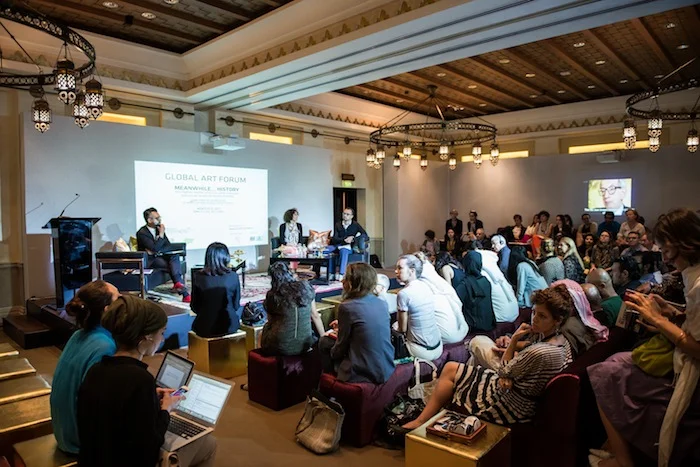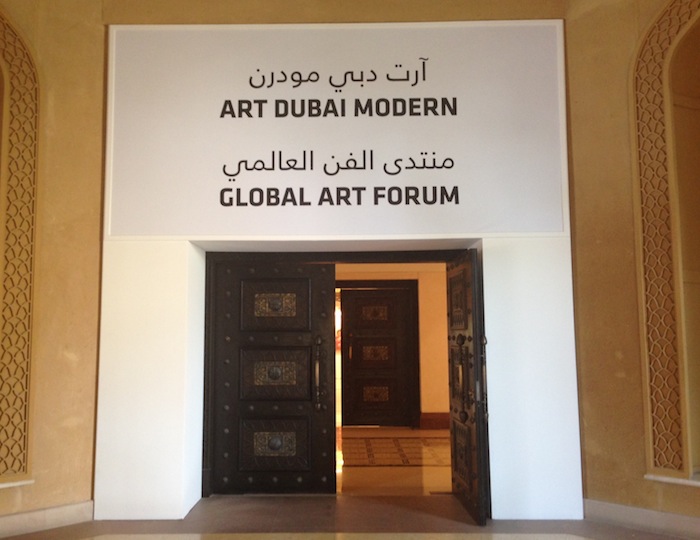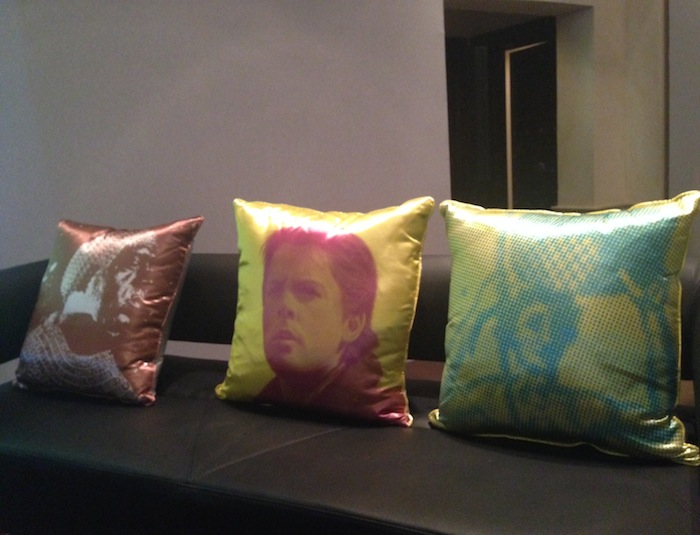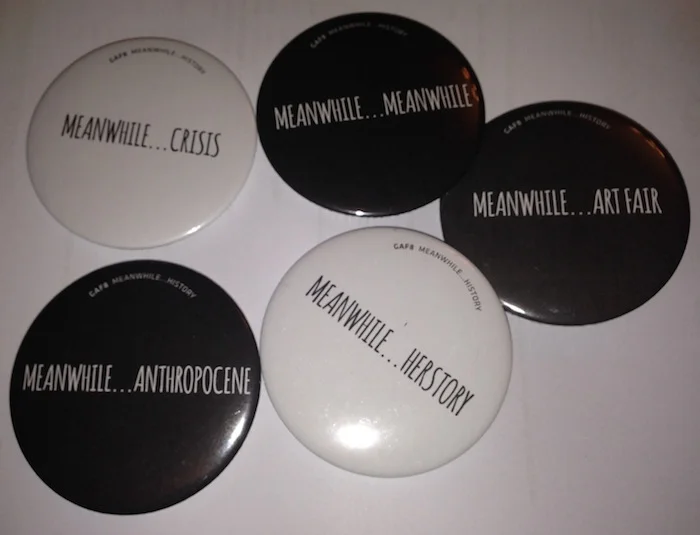Art Dubai 2014 Review - Part 1 - Global Art Forum
Global Art Forum 8 | Courtesy: Art Dubai
Here's the first of my Art Dubai 2014 reviews and thoughts. I will start with the Global Art Forum which is my favourite part of Art Dubai and what I think makes it unique compared to many art fairs around the world .
If Art Dubai is known for it's international showcase of art and a glitzy crowd, the Global Art Forum is the thinking part of the fair where you go for some intellectual stimulation.
The eighth edition of the Global Art Forum had Shumon Basar back again as the commissioner and it was co-directed by curator-translator Omar Berrada of Dar al-Ma'mun and artist Ala Younis. This year's theme was "Meanwhile...History" (a title conceived by Sophia Al-Maria).
...an imagined timeline of turning points in history – significant decades, years, days, minutes or seconds that shifted an understanding of the world. Some seem familiar. Others are broadcast from history’s blind spots. These coordinates come from the past, are present in our present and reach into the future.
'Meanwhile…History' also reflects on the philosophy and fiction of making history matter. Every commission, publication, session and presentation is a point on an imagined timeline; as a whole, the Forum becomes a journey through known and unknown histories of critical change and secretly seismic moments.
The theme intrigued me and I was hoping for a less disappointing edition compared to last year. I'm glad to report it was a good year (apart from one talk which disappointed me, a lot). I was also invited back again to participate, this time with a video montage to accompany one of the talks. More on this later.
GAF started in Doha (15th-16th March) with topics titled Spaceship Sheraton and the Making of Doha's Masterplans, The End of Pearling in the Gulf and Migrations in film and video: From the Arab world to Brazil and Back Again were discussed, and then continued in Dubai between 19th-21st March. I attended all three days of the talks in Dubai, I sat through more than 10 hours worth of talks in total.
This year's edition was live streamed on www.ibraaz.org and all the talks can be found here. Although annoyingly, the talks in Dubai are broken down by day and not by topic, and none of them are embeddable, so I can't share my favourite talks here with you.
Another new change this year was GAF's location. It was held in a smaller venue, in the Mina A'Salam Hotel, which made it feel slightly disconnected from the fair. But there was better furniture, my favourite was the Michael J. Fox cushion which was on stage all three days. I also loved this year's GAF badges, written in "teenage anxiety fonts".
© Hind Mezaina
The talks in Dubai started with the followng intro from Shumon which I'd like to share with you, to help those who have never attended get the spirit of the forum.
Over the past few years, the Global Art Forum may have questioned the inherent significance of the middle word in our title, of course that word is art. We may also have forbidden white leather sofas (but black leather is ok). And we've also waged a war against the words panel and keynote because they have a provenance which is something that we'd prefer to evade because what you are is a measure of what you definitely don't want to be.
And so the forum takes pleasure in thinking in the modes of thinking and the modes of address and it makes this public for you. It invokes Oprah Winfrey and Michel Foucault sitting on couches like these, supported by cushions like these live on television.
We try to pay attention to the rhythm of your attention. The same one that's already contending with your Facebook feeds, your email inboxes and poor wifi reception. It's why over the course of each day you'll see that we attenuate the rhythm of the sessions, and just a mental sidebar here, your attention span is by enlarge biologically 18 minutes long.
So, there are ideas and feelings and I hope feel something after you've forgotten everything else about the next three days.
As mentioned earlier, you can watch all the talks here. But here are the ones that stood out for me:
1959, 1971, 1977: In the Shadow of Bigger Things
Sulayman Al Bassam (writer and director)
Still from the online video of the talk
Beneath the shimmer and hum of Kuwait's magical golden era, laws were passed and institutions made with an aim to galvanise the notion of self, identify the common enemy and redefine the religious identity of the nascent democratic state.
In this talk, Al Bassam explores how the project of nation building unwittingly planted the seeds of internal divisions and communal mistrust that are all too prevalent in the contemporary landscape of Kuwait and beyond, and how this reading of history informs his own artistic practice.
This was my favourite talk, even though Sulayman Al Bassam ran out of time, he only managed to talk about 1959 and the early 1960s and wasn't able to cover 1971 and 1977.
It was a mini history lesson about the institutional changes that happened in Kuwait in 1959 that questioned the contending narratives around identity (what is it to be a Kuwaiti, what is Kuwait's past, who are Kuwaitis, the people who live in Kuwait?).
Al Bassam asked to look at the relationship with having a nationality, being a citizen and carrying an identity which he believes is a central question facing lots of development projects in the arts and cultural field, he said it is "vital that one has an understanding of ones identity or the identity that one is trying to build when one invests in art and culture" and later on went to descirbe the relationship between the three as a "diabolic triangle".
The early 1960s was a period of growth in Kuwait when it came to oil income, education, arts, music. We were also told about a book by Ian Fleming titled State of Excitement which he was commissioned to write by the Kuwait Oil Company in 1960 (yes, Ian Fleming of James Bond). The book was eventually banned and never got published, but a copy of it can be found in the archives of the University of Indiana.
“The Oil Company expressed approval of the book but felt it their duty to submit the typescript to members of the Kuwait Government for their approval. The Sheikhs concerned found unpalatable certain mild comments and criticisms and particularly the passages referring to the adventurous past of the country which now wishes to be ‘civilised’ in every respect and forget its romantic origins.” an extract from the front page of Fleming’s copy of ‘State of Excitement’
Another historical insight was the 1959 nationality law which consisted of eight different degrees of being a Kuwaiti, all eight degrees have equal legal and social rights but not all have equal political rights.
Sulayman Al Bassam speaks with eloquence and grace, and I am certain everyone in the room was gushing over him. Since he never had a chance to complete his talk, I hope the Global Art Forum will bring him back next year, regardless of the theme.
He was eventually asked to join the talk that took place after him (more on that below). During that session (and after watching it online again)
I noticed he rushed through a slide which featured Boney M, to play an extract from a Kuwaiti play. For that reason alone, I am going to beg Shumon Basar to bring back Mr Al Bassam.
Still from the online video of the talk
You can watch Sulayman Al Bassam's complete talk here, between 00:12 - 00:35 minutes.
1942-1982: Kuwait’s Experiments and the Confidence Interval
Farah Al-Nakib (Assistant Professor of History and Director of the Centre for Gulf Studies, American University of Kuwait) and Kristine Khouri (Researcher and writer). Hosted by Ala Younis (Artist, Curator and Co-director of Global Art Forum 8)
Still from the online video of the talk
Oil revenues rendered Kuwait's promise of progress and modernity into physical symbols. A cast of artists, architects, actors and financiers crafted an era of confidence that starts as early as the first art exhibition in 1942.
The crash of the stock market in 1982 is said to have challenged this unique experimental spirit. The peak of this “Confidence Interval” is the 1970s. Circulism, Andy Warhol, Kenzo Tange, Hassan Fathy and the Dramatic Arts are a few of its most notable contours.
I absolutely loved Farah Al-Nakib's part of this discussion which was about architecture in Kuwait, especially modernist architecture. She touched upon some very important points that are not only relevant to Kuwait, I found a lot I could relate to here in Dubai.
She discussed the demolition of the pre-oil urban landscape in Kuwait because it was perceived the "old is not worthy of admiration", a shedding of the past to replace it with a better future. And just like we see across the Gulf region today, after the Kuwait oil boom in 1973, international architects were invited, to put Kuwait on the map of cutting edge of architecture and modernity.
Kuwait pre-oil looked like any other port cities in the Indian Ocean and she showed similarities between Kuwait and Zanzibar in the 1930s and Kuwait and Beirut in the 1950s, illustrating Kuwait's hybrid cultural identity. As a port city it was always exposed and inspired by culture from countries surrounding it which is also reflected for instance in its food and even music.
Her point about how we're made to forget the history in the Gulf region because we constantly demolish and erase the past really resonated with me. It is something I see happening in Dubai today and in lots of other cities across the Gulf region. And the most important point made at this talk is that we need to remember the past and not to wipe away its physcal presence, not for nostalgic reasons, but to to allow us to critically assess our present.
Needless to say, I wanted to high five Farah Al-Nakib after her talk.
You can watch the complete "1942-1982: Kuwait’s Experiments and the Confidence Interval" talk here, starting from minute 00:36:60 till 1hr 36 mins.
2005: Alternative Futures of Art History between Iran and Dubai
Cultural historian Shiva Balaghi (Professor, Departments of History and History of Art, Brown University)
Still from the online video of the talk
Shiva Balaghi traces alternative timelines of Iranian art history in Mohammed Afkhami's Dubai-based collection.
“The present of art is always in the past and in the future.” So wrote Jacques Rancière. This sentiment extends to an art collection, which becomes a visual archive, a repository of the future of images. According to an Iranian artist in 1968, “Art can provide a vision for a way of living in an alternative future.”
My third favourite talk was by Shiva Balagi where she looked at an art collection as an archive and asked "what does it mean to have artists be history scribes and to have collectors be the archivists".
She highlighted Dubai's fundamental role in this timeline where she described Dubai as a central capital of the Iranian art world because it
...not only only provides a market for a lot of Iranian artists and a lot of Iranian collectors, but it also sustains the artistic imagination of this generation of iranian artists…and also bears witness to our modernist past.
Dubai is also a gathering place for those of us who are central figures in the Iranian art world. Some of us can't go to Iran and some of those who work in the Iranian art world can't come to Europe and United States. Dubai welcomes us all. As long as we care about art, we can gather in Dubai. This is often where i come to meet curators and artists and collectors who based in Tehran.
Shiva Balaghi transfered us into the past, going back to the early 1920s and ended with a shared history she has with Mohammed Afkhami which is embedded in art. You have to watch the full talk to see how she links all of this.
It was a very warm and fascinating talk, and included some beauiful work. My favourite was this video Balaghi played of Newsha Tavakolian's Look series. It's work I had not seen before (I'm familiar with her Listen series which I've seen in several galleries and art fairs I visited in the past couple of years). This series looks at intimacy of strangers in an isolated environment like Tehran. According to Shiva Balaghi, Newsha said this series "is about feelings and not a political statement". It's a sad but beautiful video (you can see the photos here).
You can watch Shiva Balaghi's complete talk here, starting from 2hrs 10 mins till 2hrs 36 mins.
And now for the talk that disappointed me...
1971-79: The Short Seventies (UAE)
Adina Hempel (Assistant Professor, College of Arts and Creative Enterprises, Zayed University and Head of Research for the National Pavilion of the UAE Venice Architecture Biennale 2014), Todd Reisz (Visiting Assistant Professor, Yale University School of Architecture and Editor of Al Manakh and Portal 9), Anastase Emmanuel (Urban planner and architect), H.E. Salem Al Moosa (President of Al Moosa Enterprises and CEO of megaproject "Falconcity of Wonders")
The United Arab Emirates was founded in December 1971, only a few years after oil reserves were discovered there. Nation building and the building of new city-states became intimately entwined. Modern architecture, though on the wane in the West, found itself active in the UAE, soon manifest as municipal, domestic and corporate projects.
This spirit of a new future was crystallized in the opening of Dubai’s Jebel Ali Port and World Trade Centre in 1979. However, in the accelerated time-landscape of the Gulf, this period often lacks national affection and is slowly being erased. Why?
Still from the online video of the talk - Cover image of Dubai's 1971 Masterplan by John Harris
The talk started great, when Todd Reisz introduced us to 1969 in Dubai with an image of the launching of a khazzan into the sea (large tank to store oil that was being extracted under water) a couple of years after the discovery of oil off shore. The image featured a man from an American company called Chicago Bridge and Iron Company and Sheikh Rashid bin Saeed Al Maktoum the ruler of Dubai at the time.
This event took place on a beach in Dubai which in the late 1970s had the Chicago Beach Hotel built on it, named in honour of the company and then Chicago Beach Village (a residential complex). Both hotel and residential complex were eventually demolised and were replaced with the
Jumeirah Beach Hotel, Burj Al Arab Hotel and Madinat Jumeirah, the exact spot we at the Global Art Forum were sitting on during the talk.
The point Reisz was trying to make was that "Dubai is seen as a crazy place of tabula rasa, but indeed it has levels of history". And how each year in the 1970s was a transformational point for Dubai. A lot was being built, but not to stay for a long time, Dubai was witnessing modernism that "was happening quickly", Dubai was always "projecting forward and more forward".
I was really glad this point was made because today, many people think Dubai has been going through a rapid change post 2000s, but when you look back, you will see that's always been the case here. The scales might have changed, but the constant changing and evolution of Dubai was happening since the 1970s.
Sheikh Rashid was mentioned as the master planner of Dubai and I was really enjoying where the talk was going till it got hijacked by Salem Al Moosa. His presence on stage felt more like a businessman instead of a historical or social observer of 1970s Dubai. There was a bit preachiness and Gulf chauvinism in his tone. He did share some funny anecdotes, but he really didn't add any historical or cultural insight to the talk. And at the end of the talk, he asked us to watch an "art film" he made for us. The video was of his 'mega project' Falcon City. It was certainly not an art film, it was the commercial for the dreaded Falcon City which you can see here. This session should have just had a big fat "Sponsored by Falcon City " logo in the room. It was the biggest cringe moment I've had at Art Dubai.
If you've not heard of Falcon City, it's a development project that will replicate famous landmarks from around the world - including iconic cities like New York and Paris. Basically, it's an architecture Disneyland. Yes, it's as bad as it sounds. A few years ago, this video would have been mocked at an event like the Global Art Forum, so I was shocked and disappointed when it was allowed to be shown, without any irony.
This talk would have been so much better with one moderator and one guest. And I am certain it would have been a much more qualitative talk between either Todd Reisz or Adina Hempel and Anastase (Tassos) Emmanuel. Tassos' contribution to the talk was actually quite lovely and he shared some funny anecdotes like how Sheikh Rashid wanted to build a mall by the creek just because Sharjah started to build one by their creek and discussed the zeal and enthusiasim of Sheikh Rashid's development plans for the city.
But sadly, overall, the talk didn't turn out as great as I hoped. After watching the talk again online, I realised I am fed up of Dubai getting the short end of the stick when it comes to any discussions with scholarship and real insight into a period that not many people are aware of. The Dubai narrative always just focuses on the commercial aspect of the city without any historical context. The discussions about Kuwait mentioned above (and about Doha that took place before GAF continued in Dubai) were a lot more credible. I do hope there will be other opportunities to talk about this decade of Dubai that doesn't get enough attention.
If you're interested in watching this talk, you can find it here, between 1hr 3mins and 2hr 5mins.
The last GAF talk included an intro video montage I was asked to make for it. Not many had a chance to see it, so here it is.
Meanwhile … Meanwhile: Lapses in Time and Narrative
John Akomfrah (Artist, filmmaker and writer), Marina Warner (Writer). Hosted by Omar Berrada (Writer, translator, Co-director of Dar al-Ma’mûn and Co-director of Global Art Forum 8). The session's video montage by Hind Mezaina (Artist and writer/blogger)
How does a writer or a filmmaker skip forward or flash back? And how do they account for history's gaps, elisions, and returns? What exactly happens in themeanwhile, in the two months earlier, in the ever after? What is a narrative time lapse? Let's dwell on the meanwhile - on the ghosts of time - on what embodies and disembodies it. Let's dwell in the meanwhile.
You can watch the complete talk here. It starts from 2hrs 21 mins till 3hrs 13 mins.








